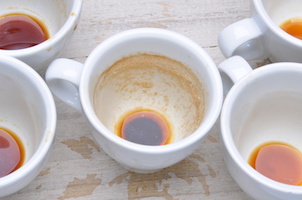 For many of us, coffee is a very enjoyable part of our day – a quick moment away from the hustle and bustle, and a welcome pick me up!
For many of us, coffee is a very enjoyable part of our day – a quick moment away from the hustle and bustle, and a welcome pick me up!
Not only is coffee in its liquid form incredibly useful, the leftover grounds are still quite marvellous. The oily rag ideas team have the following ways to make the most of your coffee grounds. If you don’t generate enough yourself, cafes are usually only too happy to donate them.
While chatting to a fellow oily ragger at our local supermarket the other day, they mentioned how well their banana plants were doing after giving them good coverage of coffee grounds. They have an arrangement with a local café to take away the grinds, which works well for both parties.
That got us searching the voluminous oily rag archives for other uses for coffee grounds. There are quite a few, from in the garden through to facial treatments!
Here are some simple uses that will get you thinking as you are about to throw away the grounds from that morning coffee!
For gardeners who can talk about fertilisers in NPK language, the coffee grounds are 2.5 – 0.3 – 0.6. Various studies have different numbers, but essentially they show that the grinds are not highly concentrated as a fertiliser. They have more nitrogen (N) than anything else, so they are good for leaf growth but do not do much for flowering or fruiting. To make the grinds a more balanced addition to the garden, add wood ash from untreated timber from your fire. In fact blending coffee grinds and wood ash would make a pretty good general fertiliser.
Use as a garden fertiliser on plants that like acidic soil. Hydrangeas are a natural litmus test and will turn a bright blue. Roses will also benefit, as will camellias. If used generally, mix the grinds with lawn clippings or leaves to reduce the acidity.
If coffee grinds are added to compost then they should account for no more than 10% to 20% of the composted material. Despite being brown, coffee grounds are considered “green” for composting, because they are heavy in nitrogen, so make sure you have plenty of brown matter too, like leaves.
When added directly around a plant, coffee grounds will act like a slow release fertiliser providing long-term nitrogen input which can then be utilised by plants.
It is an excellent growing medium for mushrooms. Carrots and radish are also coffee lovers so mix it into seed trays and into the beds.
Coffee grinds act as a repellent for garden pests like ants, snails, and slugs in the home or garden. They can be applied directly, or as a diluted spray solution. Apparently ants are not coffee drinkers because sprinkling coffee grounds at their entry points in a home or in the garden will keep the blighters away.
Grinds can also be used to deter wandering cats from doing their business on your place instead of theirs, by sprinkling them around the crime scene.
They can be used as an odour sponge – place some coffee grinds in a small open top jar and leave in the back of the fridge. A teaspoon or two in your food waste bin will help absorb any smells. Keep some coffee grounds in a container near or under your sink, and rub some on your hands after chopping garlic, onions, or other smelly things.
Add some to a cloth to use as a cleaning abrasive. Coffee grinds will act like a soft sandpaper to get rid of stubborn stains on pots and pans – or on handyman tools. They can also be used as a hand scrub or an exfoliating body scrub!
For a kids’ activity, try dipping a sheet of paper into a cold brew of coffee grounds. It gives the paper an old look which is great to use for story books.
This is not one we have tried but apparently cockroaches are coffee lovers – some have turned this weakness into their nemesis by placing moist coffee grounds into the bottom of a jar, then lining the inside top of the jar with double sided sticky tape, to act like flypaper!
When you give your dog a bath, add a tablespoon of used coffee grounds to the shampoo to help repel fleas.
But what about tea drinkers, you ask? If you have any tips of what to do with leftover tea bags or tea leaves, please drop us a note!
By Frank and Muriel Newman. Read more here.
You can share favourite tips or questions with readers by contacting us via the website at oilyrag.co.nz or by writing to Living off the Smell of an Oily Rag, PO Box 984, Whangarei.









Join the Discussion
Type out your comment here:
You must be logged in to post a comment.